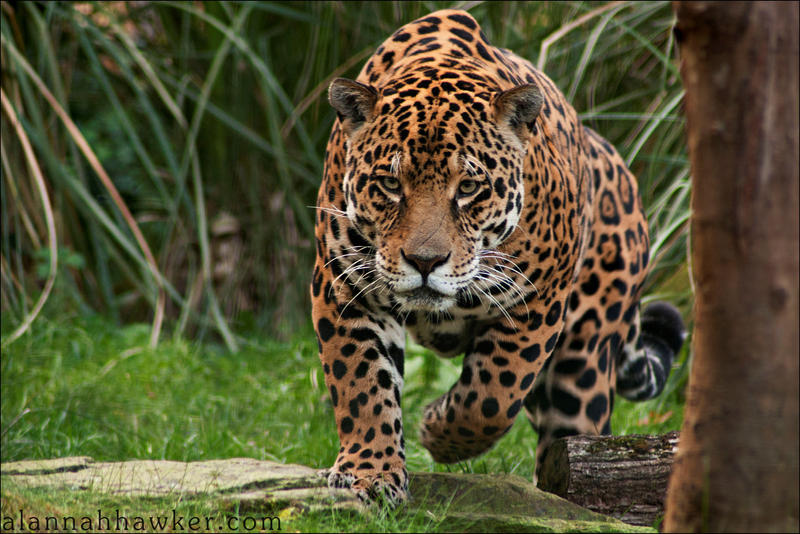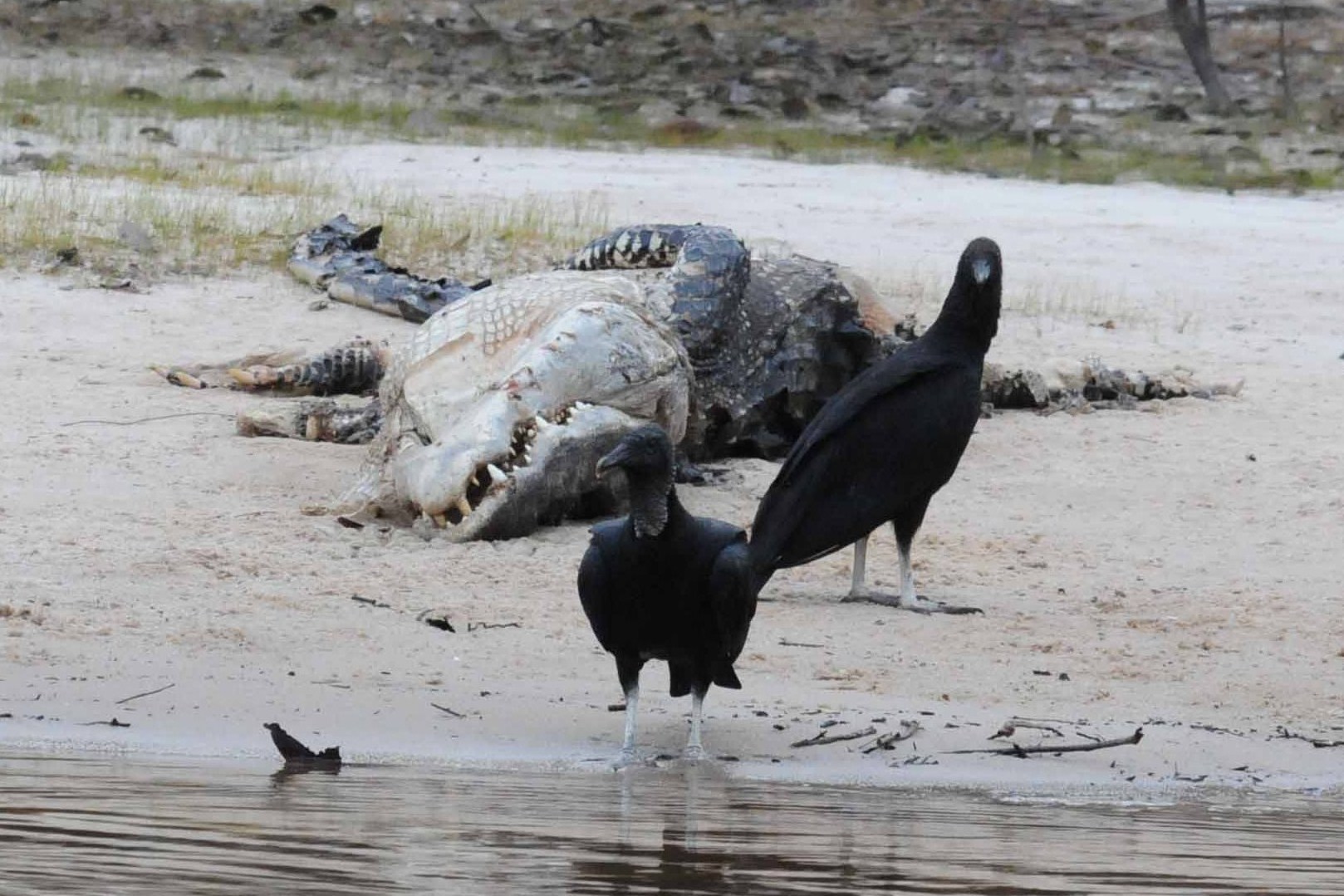|
|
Post by DinosaurMichael on Sept 18, 2013 20:13:01 GMT 5
Jaguar - Panthera onca The jaguar (Panthera onca) is a big cat, a feline in the Panthera genus, and is the only Panthera species found in the Americas. The jaguar is the third-largest feline after the tiger and the lion, and the largest in the Western Hemisphere. The jaguar's present range extends from Southern United States and Mexico across much of Central America and south to Paraguay and northern Argentina. Jaguars tend to have weights varying from 55 to 95 kg (120 to 210 lb), with the largest male ever recorded weighing 148 kg (346 lb) and the smallest females weighing 36 kg (80 lbs). A short and stocky limb structure makes the jaguar adept at climbing, crawling and swimming. The head is robust and the jaw extremely powerful. The jaguar hunts wild animals weighing up to 300 kilograms (660 lb) in dense jungle, and its short and sturdy physique is thus an adaptation to its prey and environment.  Black Caiman - Melanosuchus niger The black caiman, Melanosuchus niger, is a crocodilian. It is a carnivorous reptile that lives along slow-moving rivers and lakes, in the seasonally flooded savannas of the Amazon basin, and in other freshwater habitats in South America. The black caiman has a bony ridge over brown eyes, and black, scaly skin. The skin coloration helps with camouflage during its nocturnal hunts, but may also help absorb heat (see thermoregulation). The black caiman is one of the largest reptiles. It is the largest predator in the Amazon basin and possibly the largest member of the family Alligatoridae. Most adult male black caimans are 3.5 to 5 metres (11-16 ft), with weights ranging from 300-500 kg (660-1,100 lbs). The black caiman broadly overlaps in size with the American alligator, although it is on average larger at maturity. In some areas (such as the Araguaia River) this species is consistently reported at 4 to 5 metres (13–16 ft) in length, much larger than the alligator (which rarely even reaches 4 meters), although specimens this size are uncommon. Several unconfirmed sources report that the black caiman can grow to 6 metres (20 ft) or more. It is, however, the third largest crocodilian in South America behind the American Crocodile and Orinoco Crocodile.  Credit to Wikipedia |
|
Deleted
Deleted Member
Posts: 0
|
Post by Deleted on Sept 18, 2013 21:15:24 GMT 5
Slight edge to the Black Caiman due to size, stronger jaws and armor.
|
|
|
|
Post by Runic on Sept 18, 2013 22:12:22 GMT 5
Black Caiman, at adulthood it is too big and powerful, even on land.
|
|
wiffle
Junior Member Rank 1

Posts: 41
|
Post by wiffle on Sept 19, 2013 11:14:20 GMT 5
I don't see the jaguar beating a massive 16-footer.
|
|
Deleted
Deleted Member
Posts: 0
|
Post by Deleted on Apr 8, 2018 7:53:30 GMT 5
Me too.
|
|
|
|
Post by dinosauria101 on Feb 1, 2019 18:33:06 GMT 5
Me three. the caiman would win on land AND water at that size.
|
|
|
|
Post by jhg on Feb 3, 2019 1:54:53 GMT 5
While jaguars do kill and eat caimans, this particular species is out of its league.
|
|
|
|
Post by dinosauria101 on Feb 3, 2019 1:58:02 GMT 5
^That is a perfect analogy
|
|
rock
Senior Member Rank 1
  
Posts: 1,586
|
Post by rock on May 27, 2019 23:14:42 GMT 5
black caiman wins , it is heavier , has stronger jaws and is more durable , jaguars only go after smaller dwarf caimans and will stray away from larger caimans like the black caiman.
|
|
|
|
Post by elosha11 on May 28, 2019 18:19:31 GMT 5
What do you guys think of this supposed evidence from three different occurrences?  (1) From www.amylpeterson.com/2013/02/peacock-bass-fishing-on-the-amazon-river-the-real-story-day-2/(2) From Depredation by Jaguars on Caimans and Importance of Reptiles in the Diet of Jaguars. In June 1999, we found a male M. niger 3.8 m TL that apparently had recently been killed by a jaguar. Based on the paw marks around the site, the caiman had been attacked by the jaguar while on a thick mat of floating vegetation in a canal located along the margin of Lago Mamiraua. (3) Or what about this? This is described as a young male jaguar. I'm not sure if this is a black caiman or not, but given it's size, (it's easily larger than the jaguar), I suspect it is. pt-br.facebook.com/pantanalwildlifeexplorer/videos/241542069851504/ |
|
|
|
Post by dinosauria101 on May 28, 2019 20:30:04 GMT 5
What do you guys think of this supposed evidence from three different occurrences?  (1) From www.amylpeterson.com/2013/02/peacock-bass-fishing-on-the-amazon-river-the-real-story-day-2/(2) From Depredation by Jaguars on Caimans and Importance of Reptiles in the Diet of Jaguars. In June 1999, we found a male M. niger 3.8 m TL that apparently had recently been killed by a jaguar. Based on the paw marks around the site, the caiman had been attacked by the jaguar while on a thick mat of floating vegetation in a canal located along the margin of Lago Mamiraua. (3) Or what about this? This is described as a young male jaguar. I'm not sure if this is a black caiman or not, but given it's size, (it's easily larger than the jaguar), I suspect it is. pt-br.facebook.com/pantanalwildlifeexplorer/videos/241542069851504/That was by AMBUSH. Mountain lions and leopards kill moose and eland 10 times their weight by ambush, but they wouldn't be the favorite in a head to head fight, and the same applies here. |
|
|
|
Post by elosha11 on May 28, 2019 22:04:05 GMT 5
Well, to be fair, we only can speculate that one such attack was by ambush, (the second one based on researcher comments) as to the other two we don't know if it was ambush, direct attack, or just scavenging. No one directly observed any of these incidents. And let's also keep in mind that for the second attack (the clearest case of predation), whether it was ambush or not, it was in the water, which is supposed to be the caiman's element and where it will have the most advantage.
Honestly, it's so hard to judge these contests because each animal would necessarily be trying to take advantage of the other, as all predators do. They are interested in surviving and eating, not in what we humans think is a "fair" face to face contest. If the black caiman killed a jaguar, it wouldn't be surprising if it was by ambush (i.e., jaguar getting a drink, hidden black caiman bursts out of river and grabs it). Should we equally discount any such accounts, because it's an ambush?
BTW, does anyone have any documentation of black caiman's preying on jaguars in any setting? I haven't been able to find any.
|
|
|
|
Post by dinosauria101 on May 29, 2019 2:34:22 GMT 5
Well, to be fair, we only can speculate that one such attack was by ambush, (the second one based on researcher comments) as to the other two we don't know if it was ambush, direct attack, or just scavenging. No one directly observed any of these incidents. And let's also keep in mind that for the second attack (the clearest case of predation), whether it was ambush or not, it was in the water, which is supposed to be the caiman's element and where it will have the most advantage. Honestly, it's so hard to judge these contests because each animal would necessarily be trying to take advantage of the other, as all predators do. They are interested in surviving and eating, not in what we humans think is a "fair" face to face contest. If the black caiman killed a jaguar, it wouldn't be surprising if it was by ambush (i.e., jaguar getting a drink, hidden black caiman bursts out of river and grabs it). Should we equally discount any such accounts, because it's an ambush? BTW, does anyone have any documentation of black caiman's preying on jaguars in any setting? I haven't been able to find any. I'm not necessarily saying there aren't exceptions, but I usually find that big cats have the upper hand over crocodiles in the wild for several reasons: 1: Crocodilians don't really prey on terrestrial predators; prey is much easier to find and more abundant in water. 2: While the second account WAS in the water, it was still ambushed, and this allows for a major advantage. As I've said, leopards take down eland 10 times their weight by ambush, for instance. 3: The black caiman is about 4 times the size of the jaguar here, is face to face, fully healthy, and is willing to fight back in a fight to the death. None of that applies to jaguars vs caimans in the wild. All that being said, I respect any difference of opinion you may have, elosha. I'd also like to apologize in advance if that sounded condescending. |
|
|
|
Post by elosha11 on May 29, 2019 6:34:02 GMT 5
No need to apologize, I didn't take your comments as offensive in any way. This is just a discussion, that's all. I don't know where I fall on this conflict. I tend to think in the hypothetical posed, a max sized 5 meter black caiman facing large male jag with each fully aware of the other, the caiman will have the advantage due to its massive size advantage. But the above accounts make me believe a jaguar is a dangerous and potentially deadly opponent for even adult black caiman. I will say that if a fully grown black caiman is completely aware of a jaguar and vice versa, the chances of either animal attacking the other goes way down. Too dangerous for either of them. So in actuality, the vast majority of such conflicts and any evidence of such encounters we can find will likely be ambushes, out of necessity.
That's kind of a philosophical question we have here in these type of threads. Animals are not gladiators or MMA/boxing fighters. They don't fight or predate for our amusement or to help us gain scientific knowledge. Unless we're talking about mating/territorial fights, animal conflicts are almost always predatory attempts, which necessarily means the animal is trying to kill so they can eat; they are not trying to fight fairly. These conflicts we discuss, these hypothetical "mano a mano" "fair" face to face conflicts, in reality, rarely take place, at least in comparison to other predatory interactions. Even when dealing with two apex predators such as this, one is likely to attack the other by ambush.
|
|
|
|
Post by dinosauria101 on May 29, 2019 9:08:41 GMT 5
That's kind of a philosophical question we have here in these type of threads. Animals are not gladiators or MMA/boxing fighters. They don't fight or predate for our amusement or to help us gain scientific knowledge. Unless we're talking about mating/territorial fights, animal conflicts are almost always predatory attempts, which necessarily means the animal is trying to kill so they can eat; they are not trying to fight fairly. These conflicts we discuss, these hypothetical "mano a mano" "fair" face to face conflicts, in reality, rarely take place, at least in comparison to other predatory interactions. Even when dealing with two apex predators such as this, one is likely to attack the other by ambush. Yep, kind of my point. AvA scenarios are very rare, but cats usually try to kill crocodilans as opposed to vice versa, so that's why I find crocodilians very underrated |
|















